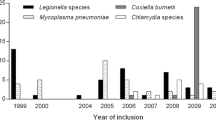Abstract
The aim of this study is to describe the changes in the aetiology of hospitalised patients with community-acquired pneumonia (CAP) during an 11-year observational period in a limited geographic area. Eight hundred and one (801) adult patients with CAP hospitalised were included. The patients were divided into three groups according to the time of presentation. Comprehensive microbiological laboratory tests were performed and differences in aetiology were analysed. In 228 patients (31%), a pathogen was detected, with Coxiella burnetii being the most common (20.1%). Significant variations in the prevalence of Chlamydophila pneumoniae were found between groups but not in other pathogens. In conclusion, long-term epidemiological studies may contribute to the knowledge of actual CAP aetiology.
Similar content being viewed by others
References
Niederman MS, Mandel LA, Anzueto A, Bass JB, Broughton WA, Campbell GD, Dean N, File T, Fine MJ, Gross PA, Martinez F, Marrie TJ, Plouffe JF, Ramirez J, Sarosi GA, Torres A, Wilson R, Yu VL (2001) American Thoracic Society. Guidelines for the management of adults with community-acquired pneumonia: diagnosis, assessment of severity, antimicrobial therapy, and prevention. Am J Respir Crit Care Med 163:1730–1754
Luna CM, Famiglietti A, Absi R, Videla AJ, Nogueira FJ, Díaz Fuenzalida A, Gené RJ (2000) Community-acquired pneumonia: etiology, epidemiology and outcome at a teaching hospital in Argentina. Chest 118:1344–1354
Ruiz M, Ewing S, Marcos MA, Martinez JA, Arancibia F, Mensa J, Torres A (1999) Etiology of community-acquired pneumonia: impact of age, comorbidity, and severity. Am J Respir Crit Care Med 160:397–405
Woodhead M (2000) Community-acquired pneumonia in Europe: causative pathogens and resistance patterns. Eur Respir J 20(Suppl 36):S20–S27
Sopena N, Sabriá M, Pedro-Botet ML, Manterota JM, Matas L, Domínguez J, Modol JM, Tudela P, Auxina V, Foz M (1999) Prospective study of community-acquired pneumonia of bacterial etiology in adults. Eur J Clin Microbiol Infect Dis 18:852–858
Marrie TJ (2004) Q fever pneumonia. Curr Opin Infect Dis 17:137–142
Sobradillo V, Zalacain R, Capelastegui A, Uresandi F, Corral J (1992) Antibiotic treatment in pneumonia due to Q fever. Thorax 47:276–278
Pascual Velasco F, Borobio Enciso MV, Gonzalez Lama Z, Carrascosa Porras M (1996) Clinical presentation of acute Q fever in Lanzarote (Canary Islands): a 2-year prospective study. Scand J Infect Dis 28:533–534
Millán Mon A, Argani Fajardo A, Febles Bethencourt J, González Caloca C, Vento Remedios TE, Fernández Cabrera M (1989) Q fever on the island of La Palma. A review of 35 patients (in Spanish). Ann Med Intern 6:527–530
Ruiz-Gonzalez A, Falguera M, Nogues A, Rubio-Caballero M (1999) Is Streptococcus pneumoniae the leading cause of pneumonia of unknown etiology? A microbiologic study of lung aspirates in consecutive patients with community-acquired pneumonia. Am J Med 106:385–390
Blasi F (2004) Atypical pathogens and respiratory tract infections. Eur Respir J 24:171–181
Lim WS, Macfarlane JT, Boswell TC, Harrison TG, Rose D, Leinonen M, Saikku P (2001) Study of community acquired pneumonia aetiology (SCAPA) in adults admitted to hospital: implications for management guidelines. Thorax 56:296–301
Viegi G, Pistelli R, Cazzola M, Falcone F, Cerveri I, Rossi A, Ugo Di Maria G (2006) Epidemiological survey on incidence and treatment of community acquired pneumonia in Italy. Respir Med 100:46–55
van der Eerden MM, Vlaspolder F, de Graaff CS, Groot T, Jansen HM, Boersma WG (2005) Value of intensive diagnostic microbiological investigation in low- and high-risk patients with community-acquired pneumonia. Eur J Clin Microbiol Infect Dis 24:241–249
Mandell LA, Bartlett JG, Dowell SF, File TM Jr, Musher DM, Whitney C, Infectious Diseases Society of America (2003) Update of practice guidelines for the management of community-acquired pneumonia in immunocompetent adults. Clin Infect Dis 37:1405–1433
Author information
Authors and Affiliations
Corresponding author
Rights and permissions
About this article
Cite this article
Fernández Álvarez, R., Suárez Toste, I., Rubinos Cuadrado, G. et al. Community-acquired pneumonia: aetiologic changes in a limited geographic area. An 11-year prospective study. Eur J Clin Microbiol Infect Dis 26, 495–499 (2007). https://doi.org/10.1007/s10096-007-0323-3
Published:
Issue Date:
DOI: https://doi.org/10.1007/s10096-007-0323-3




